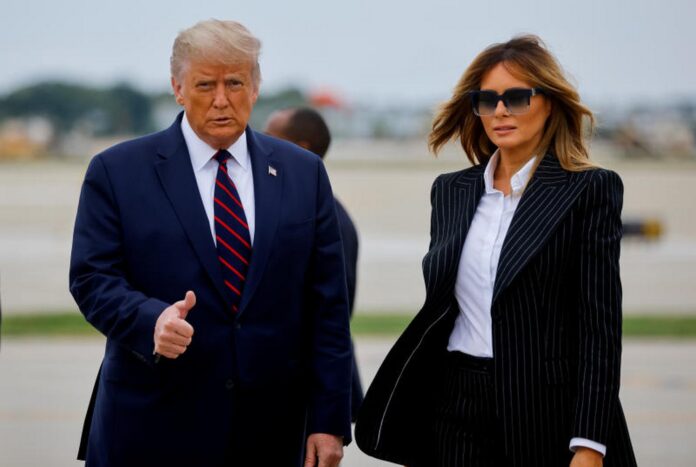
US President Donald Trump remains under scrutiny as he stays in hospital for Covid-19 treatment.
There is scepticism over the prospect – raised by doctors earlier – that he could leave on Monday as questions continue over the seriousness of his illness.
His oxygen level dipped twice and he received a steroid treatment.
On Sunday, he made a surprise public appearance in a drive-past to greet supporters, drawing criticism.
“More than 205,000 Americans are dead. We need leadership. Not photo ops,” tweeted Hakeem Jeffries, chairman of the Democrats in the US House of Representatives.
Wearing a mask, the president waved to well-wishers from behind the glass of a sealed car after tweeting that he would leave Walter Reed hospital to pay a “surprise visit” to “patriots” outside.
A doctor at the hospital strongly criticised the president’s motorcade ride due to the infection risk inside the car.
“That Presidential SUV is not only bulletproof, but hermetically sealed against chemical attack. The risk of Covid-19 transmission inside is as high as it gets outside of medical procedures,” Dr James Philips tweeted.
He said that those inside the president’s car would need to quarantine for 14 days and are at risk of getting ill.
Earlier, it emerged that the president’s condition was more serious than previously reported when he went to hospital Friday evening.
The White House had said that Mr Trump was experiencing “mild symptoms” of Covid-19, but it was confirmed at the weekend that he received supplemental oxygen after his levels dipped twice within two days.
He was given the steroid dexamethasone, which is normally reserved for serious cases, according to experts.
However, Mr Trump sought to project an image of strength, tweeting images of himself appearing to work from the hospital and a video message teasing his surprise drive past.
- Read the latest updates here
- Unanswered questions about Trump’s Covid crisis
- Who Trump met – and who’s tested positive
- ‘We’re here to tell him that we love him’
In a tweet, the president – dressed in a suit jacket and shirt with no tie – said: “I learned a lot about Covid. I learned it by really going to school. This is the real school. This isn’t the let’s read the books school. I get it and I understand it. It’s a very interesting thing, I’ll be letting you know about it.”
The president’s diagnosis, which he made public in a tweet early on Friday, has upended his election campaign. Mr Trump faces Democratic challenger Joe Biden on 3 November.
What did we learn at the weekend?
Earlier at the weekend, Mr Trump’s doctors said that the president continued to improve and might be discharged as soon as Monday.
However, Dr Sean Conley, the White House physician, disclosed that the president’s oxygen level dropped twice since his diagnosis, and he was started on dexamethasone.
The president was given extra oxygen at least once after testing positive, said Dr Conley, who also sought to clarify earlier confusion caused by conflicting statements about Mr Trump’s condition.
Speaking at a news conference at the Walter Reed National Military Medical Center close to Washington DC, Dr Conley said Mr Trump’s oxygen level dropped for the first time on Friday morning at the White House.
The president had a high fever, he said, and an oxygen level below 94% – a healthy person’s level is 95% or higher.
The second episode happened on Saturday, when the level dropped below 93%. When questioned, Dr Conley did not say whether the president had received oxygen but added that, if it had happened, “it was very limited”.
The team, Dr Conley said, decided to give Mr Trump dexamethasone, which is shown in studies to improve survival for patients in hospital with severe Covid-19.
Steroids calm down inflammation and the immune system and are already used in conditions like arthritis and asthma as well as in some severe infections. The drugs are not thought to be helpful in the early stages of a coronavirus infection.
“Given the timeline where [Mr Trump] is in the course of illness, we’re trying to maximise everything that we can do for him… We decided that in this case the potential benefits early on in the course probably outweighed any risks at this time,” Dr Conley said.
Dr Conley also addressed a conflicting account about the president’s health given shortly after his briefing on Saturday by the White House chief of staff. Mark Meadows said Mr Trump’s vital signs over the previous 24 hours had been “very concerning” and that the next 48 hours would be critical.
“I think his statement was misconstrued,” the doctor said.
However, he acknowledged giving an overly upbeat description of Mr Trump’s condition a day earlier: “I didn’t want to give any information that might steer the course of illness in another direction. And in doing so, you know, it came off that we were trying to hide something, which wasn’t necessarily true.”
The president, being 74, a man and someone categorised as obese, is in a higher-risk category for Covid-19. On Friday he was given an experimental drug cocktail injection and started a five-day course of antiviral medication remdesivir.
Dr Brian Garibaldi, who is also part of the team treating the president, said: “He feels well, he’s been up and around and our plan for today is to have him to eat and drink, be up out of bed as much as possible to be mobile.”
The doctors said the president had not had a fever since Friday and that his liver and kidney functions had remained normal. But Dr Conley refused to answer questions on whether lung scans showed any damage.
Source: BBC

